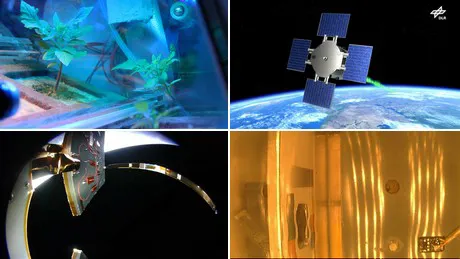The compact German Aerospace Center (Deutsches Zentrum für Luft- und Raumfahrt; DLR) Eu:CROPIS satellite is now rotating in space at a rate of 17.5 revolutions per minute, generating a gravitational force in its interior similar to that found on the Moon. After its launch on 3 December 2018, DLR engineers successfully tested and commanded the spacecraft. The experiments were then put into operation on 5 December. As the upload of updated software for the two greenhouses inside the spacecraft caused delays in January 2019, the engineers and scientists replanned the sequence of additional experiments. After the experiments with the SCalable On-BoaRd Computing Experiment (SCORE) and the RAdiation Measurement In Space (RAMIS) devices, the third experiment, PowerCell, a mission contribution from NASA, was activated under lunar gravity conditions. Software for the further activation of the greenhouses will be uploaded to the spacecraft as soon as this experiment has been completed.

Artificial gravity by rotation
"Until now, the spacecraft has been operating smoothly," explains Project Manager Hartmut Müller from the DLR Institute of Space Systems. After the successful launch, the solar panels of the spacecraft deployed as planned. An image showing the unfolded panels was sent to Earth by SCORE, the first on-board computer developed at DLR. Once the spacecraft reached its target altitude of 600 kilometres, the DLR engineers set it rotating to simulate lunar gravity, which is 0.16 times Earth gravity. "The NASA experiment was started once this was achieved." For the experiment, which is installed on the exterior of the satellite, two species of bacteria are now being brought out of hibernation in space. Later in the course of the experiment, the bacteria will produce biological substances that could also be produced during a mission on the Moon or Mars. The PowerCell experiments are scheduled to be completed in the summer of 2019.
Technology for long-term missions
The two greenhouses in which tomato seeds are to germinate under lunar and Martian conditions will then be activated. The red fruits will demonstrate that the closed life-support system, which has already been successfully tested on Earth, also functions under reduced gravity. Carbonate and synthetic urine – these substances simulate the breathing of the astronauts and the waste they produce – are converted into nutrients for the plants in the C.R.O.P. biofilter, in which bacteria live in lava rock. The unicellular algae Euglena gracilis, contributed by the Friedrich-Alexander-Universität Erlangen-Nuremberg (FAU), support the system in this process. The mission is a first step in testing how biological life support systems can be used as a technology for food supply on long-term missions. For the first time, seeds will have been germinated and plant growth observed at such a great distance from Earth.
Warmed and illuminated during hibernation
"In our laboratories here on Earth, we are currently testing how to upload the optimised software again and put the first greenhouse into operation," says Jens Hauslage, Principal Investigator for the mission at the DLR Institute of Aerospace Medicine. During the previous scheduled upload, the experimental system inside the spacecraft transitioned to safe mode. "The greenhouses are very complex and sensitive systems – even damage caused by unusually high radiation in space cannot be completely ruled out," explains the researcher. "If the experiment were located in our laboratory on Earth, it would of course be easier to understand what triggered this event. For the tomato seeds, the bacteria in the bio filter and the Euglena, the altered sequence of experiments means an additional break under comfortable conditions. The pressure container, in which the greenhouses and their passengers are located, is heated to around 17 degrees Celsius and the Euglena, which are in hibernation in damp cotton wool, are illuminated around the clock. "In this state, the biological components of the Eu:CROPIS experiment can remain in space without sustaining damage for at least nine months while waiting for it to begin."
'Breathing' of the radiation belts
Radiation researcher Thomas Berger and his team at the DLR Institute of Aerospace Medicine have been measuring radiation since 5 December 2018. For the RAMIS experiment, two identical devices are installed on the spacecraft – one on the exterior and one in the interior – to measure radiation. "The Eu:CROPIS mission is very exciting for us because the spacecraft flies over the poles and thus covers almost the entire surface of Earth during the course of its orbit," explains the investigator. "This enables us to determine the variation of galactic cosmic rays as a function of orbital position and the shielding provided by Earth’s magnetic field."
At the same time, DLR radiation researchers can study Earth’s radiation belts. Eu:CROPIS flies through the outer radiation belts, which are mainly occupied by low-energy electrons, and through the inner radiation belts (the South Atlantic anomaly), which are mainly populated with protons. The precise measurement of the outer radiation belts in particular is not possible on the International Space Station (ISS), as its orbit does not reach higher latitudes. The collected data are the basis for determining the location and intensity of the outer radiation belts, which will primarily be used to verify models of the radiation belts. "First results from the RAMIS detector on the exterior of the spacecraft clearly show the 'breathing' of the outer radiation belts – that is, the daily variation of the particle fluxes of the electrons within the belts – as well as the size of the South Atlantic Anomaly."
The use of radiation sensors inside the spacecraft is particularly important when the greenhouses are in operation. Measurements can determine how effectively the spacecraft’s shielding protects its interior against radiation, and the scientists responsible for the closed life-support system can receive information about the radiation dose to which the tomatoes have been exposed during their mission.
Source: DLR (Manuela Braun)
